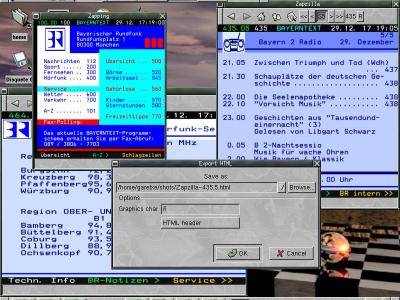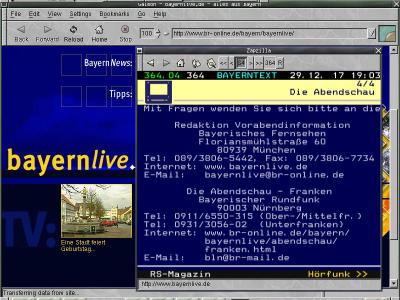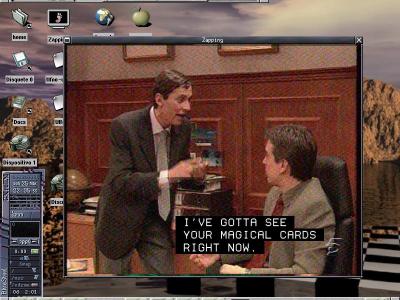Zapzilla
Zapzilla is the nickname of the Teletext browser built into
Zapping. Here's a quick overview of its features:
- Zapzilla implements the European Teletext standard
(Teletext System B, EN 300 706).
- It can display Teletext Level 1/1.5/2.5/3.5 ("HiText")
pages with 4096 colors, graphics, bold and italic
characters, double width and/or height characters,
concealed and flashing text.
- All Teletext character sets are supported, for example
Turkish, Russian, Greek, Hebrew and Arabic. Users can
override the character encoding, which isn't always
correctly transmitted, and the selected encoding is saved
across sessions.
- Zapzilla can show different pages in multiple windows.
The main window can also display Teletext instead of video,
either in a window, full-screen or as desktop background.
- The text brightness and contrast are adjustable.
- Zapzilla does not support custom fonts yet, but Teletext
windows can assume any size and the page is scaled
accordingly.
- Teletext pages can be overlaid onto video, e.g.
subtitles, news flashes, or interactive pages.
- All displayed pages update in real time, for example the
clock and "rolling" page number in the header.
- To change pages users can enter a page number, press
cursor keys or click on toolbar buttons. Remote controls
are also supported.
- Clicking on a page or subpage number in the text opens
the page in the same or a new window. Like web browsers,
Teletext windows have a forward, back and home button.
- Clicking on a URL in the text opens the page in a web
browser. E-mail addresses open an e-mail client.
- TOP and FLOF navigation is supported. The TOP page index
appears in a drop-down menu. TOP and FLOF links can be
clicked on like page numbers. All pages of a channel are
stored in memory for instant access.
- The Teletext cache can store pages of multiple channels
to reduce wait times and to view pages of another channel
than the one currently tuned in. The amount of memory
consumed by Zapzilla is user definable.
- Users can search the Teletext cache, optionally using
Unicode regular expressions. Currently this works with all
character sets except Hebrew and Arabic, and on mixed
language pages.
- Pages can be saved in HTML, PNG, PPM, and VTX format, or
as plain text with or without colors.
- Users can mark text with the pointer and copy it into
other applications, as text or image, with a middle mouse
button click (drag & drop) or by pasting from the clipboard.
Flowing (as in a web browser) and tabular text selection
is possible.
- Pages can be bookmarked.
Screenshots
If you're not utterly impressed by now, here are the
carefully crafted screenshots you've been waiting for. Note
they were taken from version 0.6. The user interface changed
completely in the meantime and I'm too busy to update this page.
Donations welcome.
 OK, many things:
OK, many things:
There are three Teletext windows here, one of them is the
Zapping main window acting as a Teletext viewer. You can see
the graphics in the page. Note the arbitrary scaling, each
Teletext page has a different size. The open dialog lets you
export a page to the previously mentioned formats, here to an
HTML page.
 Apparently nothing special here, just
Galeon and Zapzilla... until your neuronal network sees the
pattern: "Perhaps the URL in Galeon has been opened by clicking
on the link that appears in the Teletext page?". You are
completely right, so I don't need to explain anything. I will
just tell that email adresses and page numbers are clickable
too. The cryptic message in the bottom row is part of the TOP
navigation, also hyperlinks.
Apparently nothing special here, just
Galeon and Zapzilla... until your neuronal network sees the
pattern: "Perhaps the URL in Galeon has been opened by clicking
on the link that appears in the Teletext page?". You are
completely right, so I don't need to explain anything. I will
just tell that email adresses and page numbers are clickable
too. The cryptic message in the bottom row is part of the TOP
navigation, also hyperlinks.
 Zapzilla supports searching for
regular expressions in the page memory. I gave the
#email# pattern to search for, the highlight text is the
second match. The window in the back is the help window that
appears when you click the "Help" button. And in case you are
wondering, "#email#" isn't a regular expression, it's
just a convenient alias I added that expands into one horrific
expression like "([:alnum:]|[-~.]+@([:alnum:]|[-~.])+)".
Basically it matches email adresses. Similarly you can use the
"#url#" alias to match WWW addresses.
Zapzilla supports searching for
regular expressions in the page memory. I gave the
#email# pattern to search for, the highlight text is the
second match. The window in the back is the help window that
appears when you click the "Help" button. And in case you are
wondering, "#email#" isn't a regular expression, it's
just a convenient alias I added that expands into one horrific
expression like "([:alnum:]|[-~.]+@([:alnum:]|[-~.])+)".
Basically it matches email adresses. Similarly you can use the
"#url#" alias to match WWW addresses.
 This isn't properly Zapzilla,
but the subtitle overlay built into Zapping in concert with the
Closed Caption decoder built into libzvbi. Teletext subtitles
are supported in the same way.
This isn't properly Zapzilla,
but the subtitle overlay built into Zapping in concert with the
Closed Caption decoder built into libzvbi. Teletext subtitles
are supported in the same way.


 Apparently nothing special here, just
Galeon and Zapzilla... until your neuronal network sees the
pattern: "Perhaps the URL in Galeon has been opened by clicking
on the link that appears in the Teletext page?". You are
completely right, so I don't need to explain anything. I will
just tell that email adresses and page numbers are clickable
too. The cryptic message in the bottom row is part of the TOP
navigation, also hyperlinks.
Apparently nothing special here, just
Galeon and Zapzilla... until your neuronal network sees the
pattern: "Perhaps the URL in Galeon has been opened by clicking
on the link that appears in the Teletext page?". You are
completely right, so I don't need to explain anything. I will
just tell that email adresses and page numbers are clickable
too. The cryptic message in the bottom row is part of the TOP
navigation, also hyperlinks. Zapzilla supports searching for
regular expressions in the page memory. I gave the
#email# pattern to search for, the highlight text is the
second match. The window in the back is the help window that
appears when you click the "Help" button. And in case you are
wondering, "#email#" isn't a regular expression, it's
just a convenient alias I added that expands into one horrific
expression like "([:alnum:]|[-~.]+@([:alnum:]|[-~.])+)".
Basically it matches email adresses. Similarly you can use the
"#url#" alias to match WWW addresses.
Zapzilla supports searching for
regular expressions in the page memory. I gave the
#email# pattern to search for, the highlight text is the
second match. The window in the back is the help window that
appears when you click the "Help" button. And in case you are
wondering, "#email#" isn't a regular expression, it's
just a convenient alias I added that expands into one horrific
expression like "([:alnum:]|[-~.]+@([:alnum:]|[-~.])+)".
Basically it matches email adresses. Similarly you can use the
"#url#" alias to match WWW addresses. This isn't properly Zapzilla,
but the subtitle overlay built into Zapping in concert with the
Closed Caption decoder built into libzvbi. Teletext subtitles
are supported in the same way.
This isn't properly Zapzilla,
but the subtitle overlay built into Zapping in concert with the
Closed Caption decoder built into libzvbi. Teletext subtitles
are supported in the same way.